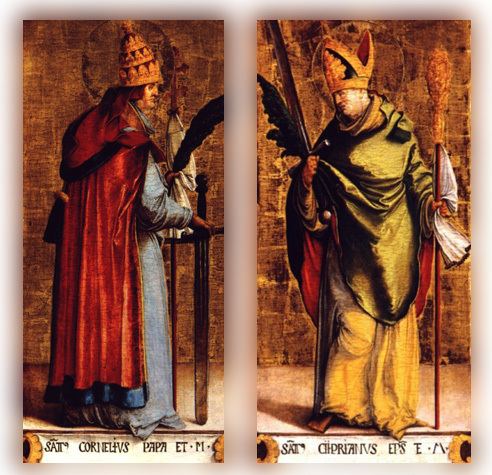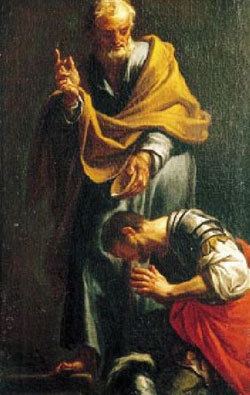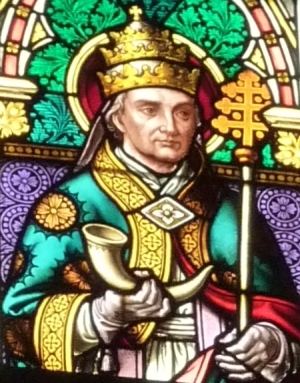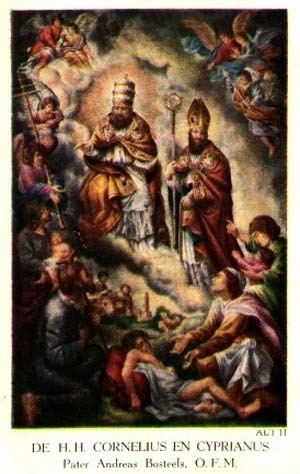Papacy began 6 or 13 March 251 Name Pope Cornelius Papacy ended June 253 | Birth name Cornelius Successor Pope Lucius I Feast day 16 September | |
 | ||
Died 253 AD, Civitavecchia, Italy Similar Saint Maurice, Magnus of Cuneo, Constantius (Theban Legion) | ||
അനുദിന വിശുദ്ധർ (Saint of the Day) September 16th - Martyr Pope Cornelius & St. Cyprian
Pope Cornelius (died June 253) was the Bishop of Rome from 6 or 13 March 251 to his martyrdom in 253.
Contents
- Saint of the Day September 16th Martyr Pope Cornelius St Cyprian
- Christian persecution
- Papacy
- Death and letters
- Veneration
- References

Christian persecution

Emperor Decius, who ruled from 249 to 251 AD, persecuted Christians in the Roman Empire rather sporadically and locally, but starting January in the year 250, he ordered all citizens to perform a religious sacrifice in the presence of commissioners, or else face death. Many Christians refused and were martyred (possibly including the pope, St Fabian, on 20 January), while others partook in the sacrifices in order to save their own lives. Two schools of thought arose after the persecution. One side, led by Novatian, who was a priest in the diocese of Rome, believed that those who had stopped practising Christianity during the persecution could not be accepted back into the church even if they repented. Under this philosophy, the only way to re-enter the church would be re-baptism. The opposing side, including Cornelius and Cyprian the Bishop of Carthage, did not believe in the need for re-baptism. Instead they thought that the sinners should only need to show contrition and true repentance to be welcomed back into the church. In hopes that Christianity would fade away, Decius prevented the election of a new pope. However, soon afterwards Decius was forced to leave the area to fight the invading Goths and while he was away the elections for pope were held. In the 14 months without a pope, the leading candidate, Moses, had died under the persecution. Novatian believed that he would be elected, however Cornelius was unwillingly elected the twenty-first pope in March 251.
Papacy

Novatian was very angry not only that he was not elected pope, but that someone who did not believe in rebaptism was. He thus proclaimed himself the antipope to Cornelius, driving a schism through the church. After Cornelius's appointment to the papacy, Novatian became more rigorous in his philosophy, convinced that bishops could not pardon the worst of sins, and that such sins could only be reconciled at the Last Judgment. Cornelius had the support of St. Cyprian, St. Dionysius, and most African and Eastern bishops while Novatian had the support of a minority of clergy and laymen in Rome who did not acknowledge Cornelius as pope. Cornelius's next action was to convene a synod of 60 bishops to restate himself as the rightful pope and the council excommunicated Novatian as well as all Novatianists. Also addressed in the synod was that Christians who stopped practising during Emperor Decius's persecution could receive communion only after doing penance.

The verdict of the synod was sent to the Christian bishops, most notably the bishop of Antioch, a fierce Novatian supporter, in order to convince him to accept Cornelius's power. The letters that Cornelius sent to surrounding bishops provide knowledge of the size of the church during the period. Cornelius mentions that at the time, the Roman Church had, "forty six priests, seven deacons, seven sub-deacons, forty two acolytes, fifty two ostiarii, and over one thousand five hundred widows and persons in distress." His letters also inform that Cornelius had a staff of over 150 clergy members and the church fed over 1,500 people daily. From these numbers, it has been estimated that there were at least 50,000 Christians in Rome during the papacy of Pope Cornelius.
Death and letters

In June 251, Decius was killed in battle with the Goths; immediately following this Trebonianus Gallus became Emperor. Persecution began again in June 252, and Pope Cornelius was exiled to Centumcellae, Italy, where he died in June 253. The Liberian catalogue lists his death as being from the hardships of banishment; however, later sources claim he was beheaded. Cornelius is not buried in the chapel of the popes, but in a nearby catacomb, and the inscription on his tomb is in Latin, instead of the Greek of his predecessor Pope Fabian and successor Lucius I. It reads, "Cornelius Martyr." The letters Cornelius sent while in exile are all written in the colloquial Latin of the period instead of the classical style used by the educated such as Cyprian, a theologian as well as a bishop, and Novatian, who was also a philosopher. This suggests that Cornelius did not come from an extremely wealthy family and thus was not given a sophisticated education as a child. A letter from Cornelius while in exile mentions an office of "exorcist" in the church for the first time. Canon law has since then required each diocese to have an exorcist.
Veneration
Some of his relics were taken to Germany during the Middle Ages; his head was claimed by Kornelimünster Abbey near Aachen. In the Rhineland, he was also a patron saint of lovers. A legend associated with Cornelius tells of a young artist who was commissioned to decorate the Corneliuskapelle in the Selikum quarter of Neuss. The daughter of a local townsman fell in love with the artist, but her father forbade the marriage, remarking that he would only consent if the pope did as well. Miraculously, the statue of Cornelius leaned forward from the altar and blessed the pair, and the two lovers were thus married.
Cornelius, along with Quirinus of Neuss, Hubertus and Anthony the Great, was venerated as one of the Four Holy Marshals in the Rhineland during the late Middle Ages.
A legend told at Carnac states that its stones were once pagan soldiers who had been turned into stone by Cornelius, who was fleeing from them.
The Catholic Church commemorated Cornelius by venerating him, with his Saint's Day on 16 September, which he shares with his good friend St. Cyprian. His Saint's Day was originally on 14 September, the date on which both St. Cyprian and St. Cornelius were martyred, as proposed by St. Jerome. St. Cornelius's saintly name means "battle horn", and he is represented in icons by a pope either holding some form of cow's horn or with a cow nearby. He is the patron against earache, epilepsy, fever, twitching, and also of cattle, domestic animals, earache sufferers, epileptics, and the town of Kornelimünster, Germany, where his head is located.
